
Swastika-Most sacred symbol of all ancient civilization
In my previous article (Click here ), we saw the findings of ancient Swastika symbol across various ancient sites of Europe. In this article, we will see the symbol of swastika unearthed from other major ancient civilizations.
Swastika in Japan
Swastika holds a special place in hearts of the Japanese. Most of the Japanese are Buddhists and since swastika (locally called as manji) is sacred in Buddhism; swastika is also sacred to Japanese people. However, this is not the only reason. Use of swastika in Japan is much older than the spread of Buddhism in Japan. Anticlockwise Swastika is called as gyaku manji, meaning "reverse manji. Even, the national flag of Japan in some way have the swastika symbol. In one of my previous article, I have given the evidence of Swastika symbolizing the moving sun”. You will notice a red circle on Japanese flag which represents the "rising sun and so, The Japanese call themselves as ‘Son of the Rising Sun’.


Many Japanese scholars claims swastika as their most sacred ancient symbol. This flag is not modern and has been in use for at least 1000 years. One of the reason for this rising sun symbol may be that Japan (Other being Australia and new Zealand) is amongst the first few countries where the sun rises first. One of the most commonly used patterns of swastika in Japan is sayagata. Sayagata Comprises of both left- and right-facing swastikas joined by lines. Further, If you Google out Japanese maps, you will find use of swastika as a marking to locate Buddhist temple.

Symbol of Swastika to represent Buddhist temple
Swastika in China
It is said that about 200 years ago, when Buddhism spread from India to china, china borrowed the auspicious sign of Swastika along with its meaning and significance. Locally, Swastika was used as a symbol to represent WAN, meaning “ten thousand”, an auspicious number to classial Chinese. Based on this symbol, Swastika shaped Hall of “Peace and Harmony” in Ten Thousand Directions was designed and constructed at the Imperial Summer Palace.
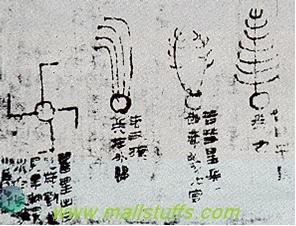
Silk cloth with swastika, carbon dated to 2300 years old, found in 1970 near Mawangdui, China
Tibetans uses Swastika on the doors of their houses as protection against evil and destruction. Tibetans calls swastika as yung-drung and treat it as a symbol of endless time, prosperity, renewal and auspiciousness. Swastikas are commonly found on Buddha statues all across Asia. The massive Buddha statue 100 feet tall made entirely of bronze can be seen at Hong Kong's Lantau Island.
Swastika in Egypt
Swastika predates Ankh, the ancient Egyptian symbol. The swastika was also found in excavation across Egyptian sites though none of the archaeologists were able to find out its meaning and significance in ancient Egyptian cultures. Coins with embedded Swastika excavated fom Egypt can be seen at the V&A Museum of London
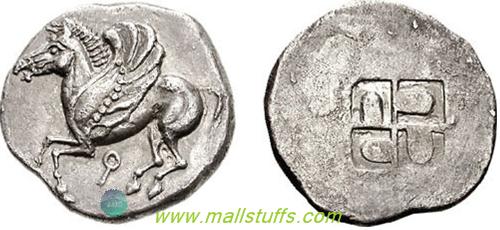
Dated between AD300-600, this artifacts were found at Qau-el-Kebir, near Asyut
Mosaics with beautifully decorated swastika were excavated at ancient Egyptians sites of sabratha in Libya.
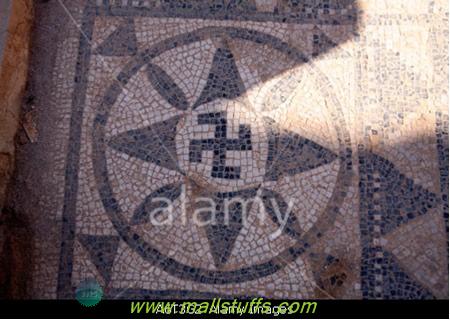
Reversed swastika in a floor mosaic
Swastika in Persia
Even to the ancient Zoroastrians of Persia, swastika symbolized the revolving sun, source of natural fire, creation and life. One of the earliest swastikas dated to 4000 BC is found on a pottery bowl excavated at ancient Baghdad (ancient Samarra).

Swastikas have been found on many artifacts such as coins, sculptures, pots, plates etc
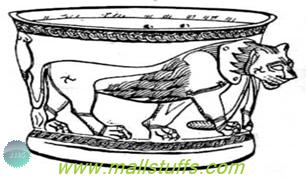
Gold Rhyton, Kelardasht, 800-700 BC
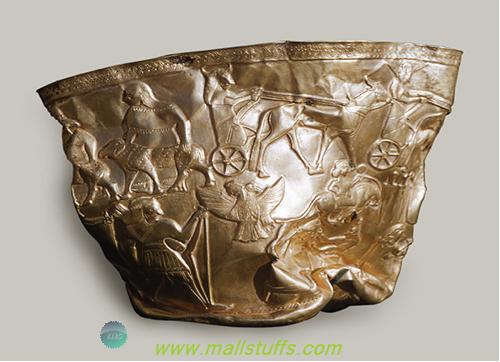
Gold Bowl with swastika in Iran Bastam Museum, Tehran
Swastika in Celt culture
Swastika has been used extensively by Celtics. Hundreds of artifacts with embedded beautiful swastika designs were found in pottery, scultures, religious woship places etc.
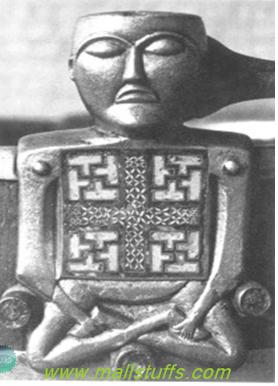
Celtic Buddha with in scripted Swastika
In above artifact, Statue of Lord Buddha with four swastikas on the chest is shown sitting in yogic meditation form called as Asana”
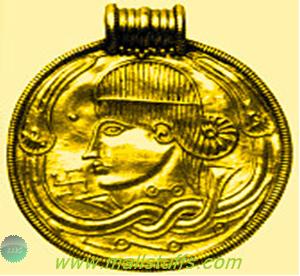 Looping Celtic Snake Hair Swastika Medallion
Looping Celtic Snake Hair Swastika Medallion
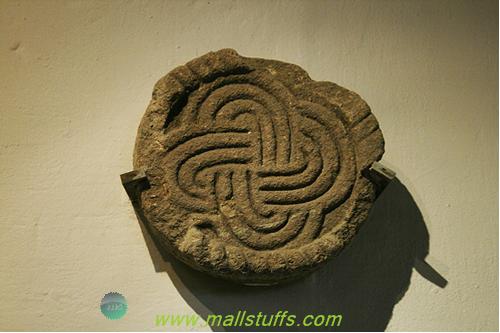
Stone Celtic swastika shown in an exhibition at the Museum of Monte Santa Tecla

Celtic swastika stone - Situated on Woodhouse Crag
Swastika found in many churches of celtic region suggests that these churches were ancient temples of the Celts which later got converted into Churches, just like the largest hindu temple “angkor wat” of cambodia got converted into buddhist temple. Christain preists often accord celts as a pagan culture yet they use their sacred symbol on their churches.
Many Europeans and Americans are continuously striving to find out about their lost culture and hence, are excavating in different geographical areas to dig out more artifacts and evidences.

Celtic symbol called tetrasquel, the tetrasquel and his brother the triskelion

Stone Coin Celtic Swastika
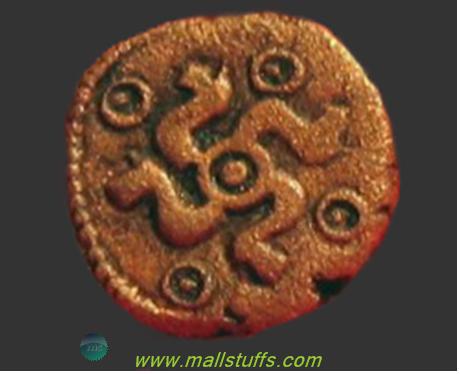
Celtic Swastika Coin
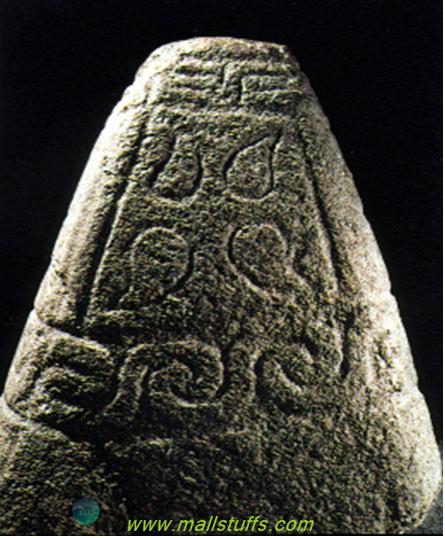
Pyramid Celtic Swastika Stone
 Celtic triple swastika symbol -symbolizing three eyed god Shiva
Celtic triple swastika symbol -symbolizing three eyed god Shiva
All these artifacts showcase the rich cultural heritage of the Celts. There is an ancient story of Celtic warrior tribes, known as Picts, who were glorified for their arts which is very evident from the carved stones found across England, Scotland and other parts of Europe. Their artworks also includes various forms of simple and complex swastikas. One example of such artwork is grave slab of Meigle Museum in Australia. This swastika is known as Gammadion, derived after a Greek word "gamma". Such Gammadion was also found during excavation in wigtownshire province where it is known as Barhobble cross slab and has been dated back to 10th Century AD.
Swastika in Mayan Culture
Mayans believed the universe as flat and square and worshipped the swastika circle, which symbolized perfection or the balancing of forces. Incidentally, relations between Indian and Mayan civilizations are often depicted in Indian literature where the Mayans civilization was said to be the civilization of demons. Since the demons had magical illusive powers, their civilization was termed as Mayan. (Maya means illusion in Sanskrit). There are many other evidences depicting the link of Mayans with India, however in this article, I would stick to the topic of swastika.
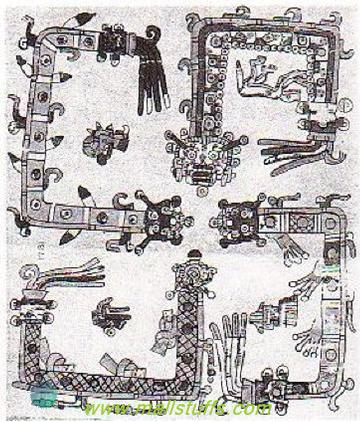
Mayan swastika
Swastika in Native America
Native American tribes, better known as Navajo used swastika in healing rituals. Swastika meant sun to Native Americans but was also used to symbolize energy. Native Americans used swastika on bowls, healing sticks, pots, garments, blankets etc. many of such objects were found in excavation sites of Ohio and Mississippi River Valleys.
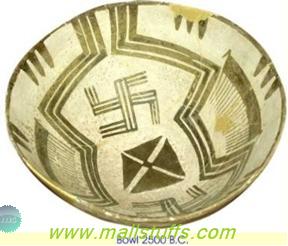
Bowl excavated at missipii river valley 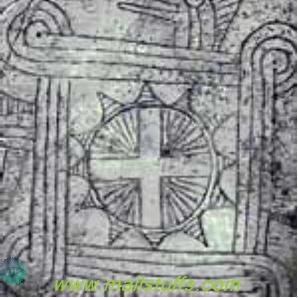
Artifact found at missippi river excavation site
Swastika in Korea In korea, Swastika is used in all Buddhist temples as a symbol of prosperity and good fortune. Many Buddhist statues with swastikas at the heart and feet can be found all across korea. Like Japan, Swastika is called as Manji in korea. Even in Korean maps, you will find a manji(Swastika) sign as a symbol to denote Buddhist temples 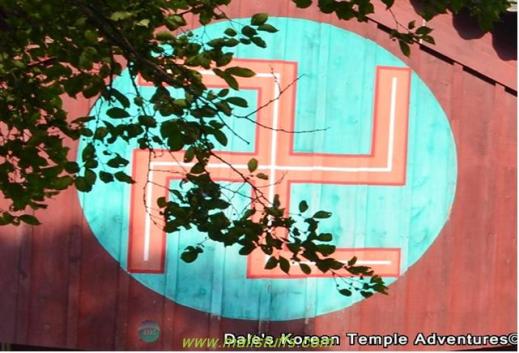
The Manja(Swastika) at Beopcheonsa Temple.
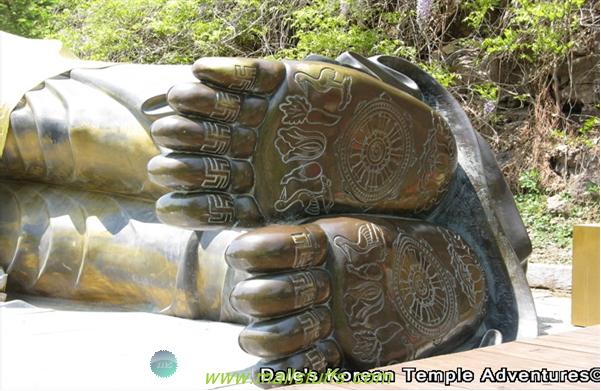
The feet of lord Buddha adorned with Manja symbol at Manbulsa Temple in Yeongcheon
Although swastika originally had a deep spiritual meaning, later it was adopted as a symbol to denote a lucky or auspicious object. Swastika was marked upon persons and things so as to denote prosperity and good luck. It name has changed across various cultures but it deep spiritual meaning and essence still exists in some eastern cultures like the Indians, Chinese and Japanese.
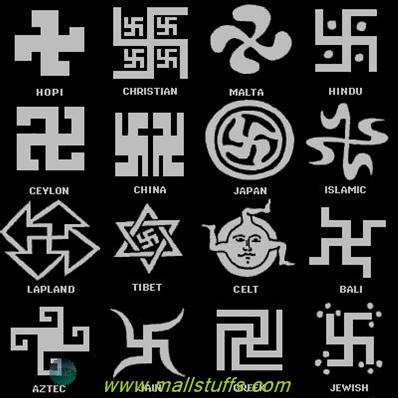
In India, Clockwise and anti-clockwise swastika means the evolution and dissolution of the Cosmos, locally called as “period of Sandhya”. For Indians, four arms of the swastika represent the four major rivers flowing from Lake Mansarovar, the Indus, the Brahmaputra, the Sutlej, and the Karnali. Their waters are the only source of irrigation for millions of farmers in india, Pakistan and Bangladesh. Hence the swastika is a life-giving mark which also stands for the union of opposites.
Also 'the relation of the Seen to the Unseen,' and 'the first procreation of man and species'. The bent arms also signify the continual revolution of the invisible cosmos of forces, which on our plane becomes the revolution in time of the world's axes and their equatorial belts. In alchemy its shows that by the unceasing revolution of the four elements, equilibrium about a stable center is attained, the circle is generated out of straight lines, the complex and changeful nature becomes one. The two crossed lines represent spirit and matter, male and female, positive and negative. It shows man to be a link between heaven and earth, for the horizontal arm having one hook pointing up, the other down. In its applicability to all planes it contains the key to the seven great mysteries of cosmos.
Conclusion
Since the inception of mankind, swastika has been used as a noble and sacred symbol of cosmic order and stability. Swastika is found on stone carvings, pots, sculptures, coins across the various ancient sites of the world which suggests swastika as a universal intuitive symbol of the Collective Unconscious. It has been used as a symbol since a time when whole humankind was of one race, most probably from India, before dispersing all over the globe.
Note: Images used on this website
are either a production of Bhaktivedanta Book Trust(https://www.krishna.com), Iskcon
Foundation or were found in google search under "Free to use and share". If any
of the images presented here violates copyright issues or infringes anyone copyright
or are not under "Fair use", then please bring it to our notice. Read
Disclaimer for more.
Share this to your friends. One of your friend is
waiting for your share.
Related Articles
Did Greeks worshipped lord krishna
Swastika-Most sacred symbol of all ancient civilization
Who invented snakes and ladders
Meaning of word Bihar and why bihari is proud of their culture and origin
Science in Hinduism-Large numbers and infinity
Chanakya Arthashastra-Greatest book on spying and secret agenies
Origin of word Hindu
Chanakya-The greatest diplomat cum politican of all times
Hinduism greatness quotes by famous philosophers and scientists
Did Egyptians worshipped lord krishna
Post Comment